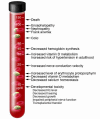Childhood lead poisoning: the torturous path from science to policy
- PMID: 16585952
- PMCID: PMC1421365
- DOI: 10.1172/JCI28232
Childhood lead poisoning: the torturous path from science to policy
Abstract
The long history of lead poisoning provides many lessons about the process by which scientific knowledge is translated into public health policy. In the United States, lead was added to paint and to gasoline in enormous quantities long after medical evidence clearly showed that excessive lead exposure caused considerable morbidity in the population. This article discusses some of the factors that contributed to the slow pace of efforts to address this problem, including the ubiquity and magnitude of lead exposure during much of the twentieth century, which produced a distorted notion about the blood lead level that can be considered "normal"; the prevailing model of disease during this period, notably the novelty of the concept of subclinical disease; the fact that childhood lead poisoning affected mostly families that were politically and economically disenfranchised, fostering a "blame the victim" attitude; and that controlling lead exposure would have impeded efforts to achieve other desirable goals, illustrating the role that value trade-offs often play in policy decisions.
Figures




References
-
- Tackett S.L. The Franklin letter on lead poisoning. J. Chem. Educ. 1981;53:274.
-
- Oberle M. Lead poisoning: a preventable childhood disease of the slums. Science. 1969;165:991–992. - PubMed
-
- Lewis J. US Environmental Protection Agency.; 1985. Lead poisoning: a historical perspective.
-
- Annest J.L., et al. Chronological trend in blood lead levels between 1976 and 1980. N. Engl. J. Med. 1983;308:1373–1377. - PubMed
Publication types
MeSH terms
Substances
LinkOut - more resources
Full Text Sources
Research Materials

